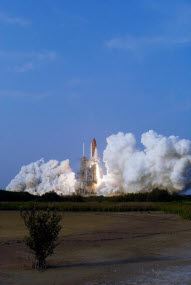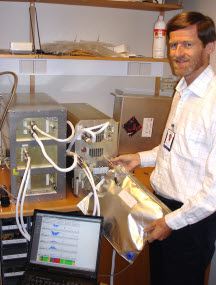
|
With technology from SINTEF stowed in its hold, the space shuttle "Endeavour" was launched from the Kennedy Space Center in Florida on August 9th. Photo: NASA/Sandra Joseph, Tony Gray, Robert Murray. |
In a few weeks, the 59-year-old SINTEF senior scientist will sit in a control room at NASA in Houston, where he will check that everything is working properly when the equipment is installed in the International Space Station (ISS).
Tests on board the Space Station
ANITA will be tested on board the ISS for ten days. If the instrument passes its exams, the next version could become the space station’s regular air-quality monitoring system.
However, the equipment will not be switched off when the ten-day test phase is over. Since it is already installed, NASA will use it to acquire better air-quality data in the ISS, in the first instance for six months.
“Down-to earth” benefits too
The measurement system, known as ANITA, is the result of a cooperative project between SINTEF and the German company Kayser-Threde GmbH. But although Honne has been project manager on the Norwegian side since day one of the project, he is no “space freak”.
“My involvement, and SINTEF’s, is due to the fact that the measurement technology involved is also highly suitable for use on Earth. It can be used for everything from monitoring industrial processes to checking the indoor climate of submarines and other environments where such checks are important”, says Honne.
All the same, it is a feather in his cap that the system should have become part of the space adventure.
“It is the most demanding market you can image”, says Honne proudly.

|
SINTEF scientist Atle Honne with the gas measurement equipment that is about to be installed in the International Space Station. The instrument normally analyses the air around it completely automatically. But air samples can also be collected elsewhere and fed into the measurement unit via gas-bags, as Honne demonstrates in this image. Photo: SINTEF Media |
The idea of ANITA is to prevent astronauts in the Space Station from having to breathe in unpleasant, toxic or carcinogenic gases.
Just as on Earth, gases diffuse out of walls, furnishings and equipment. Others may come from leakages or overheating, while the human body also emits gases. ANITA will enable astronauts to adopt countermeasures in the event of leaks or failures of the air purification system.
The gas monitoring equipment already installed on board the ISS measures only a few gases frequently and rapidly. Others are checked with a reaction time measured in hours, while some can only be measured after air samples have been returned to Earth.
Rapid but sensitive
ANITA is the leading candidate to take over the measurement programme on a permanent basis.
The wholly automatic system is sensitive, recognises and indicates the concentrations of individual gases, works rapidly and can present its results without delay. It “sees” the gases by means of beams of infrared light. Honne has developed the methods that the system uses to interpret its measurement data.
Back on Earth, Honne regards an ideal working day as one during which he has helped to produce results that “improve human health and make a few companies more wealthy, while giving me some interesting work to do”.
By Svein Tønseth |
